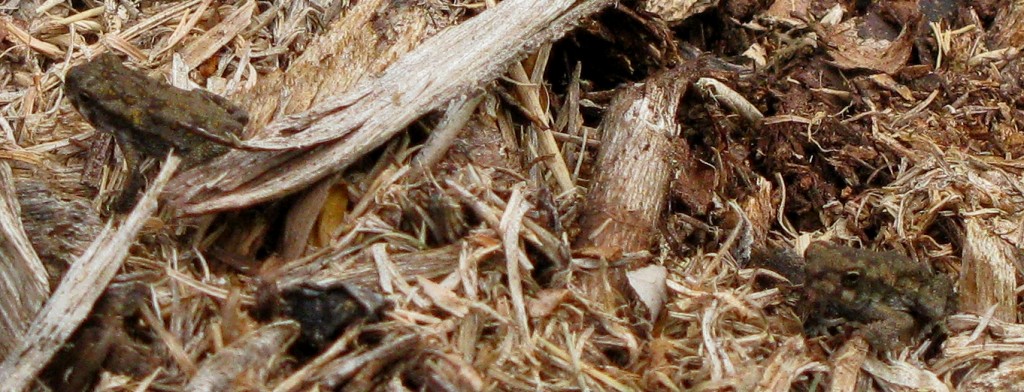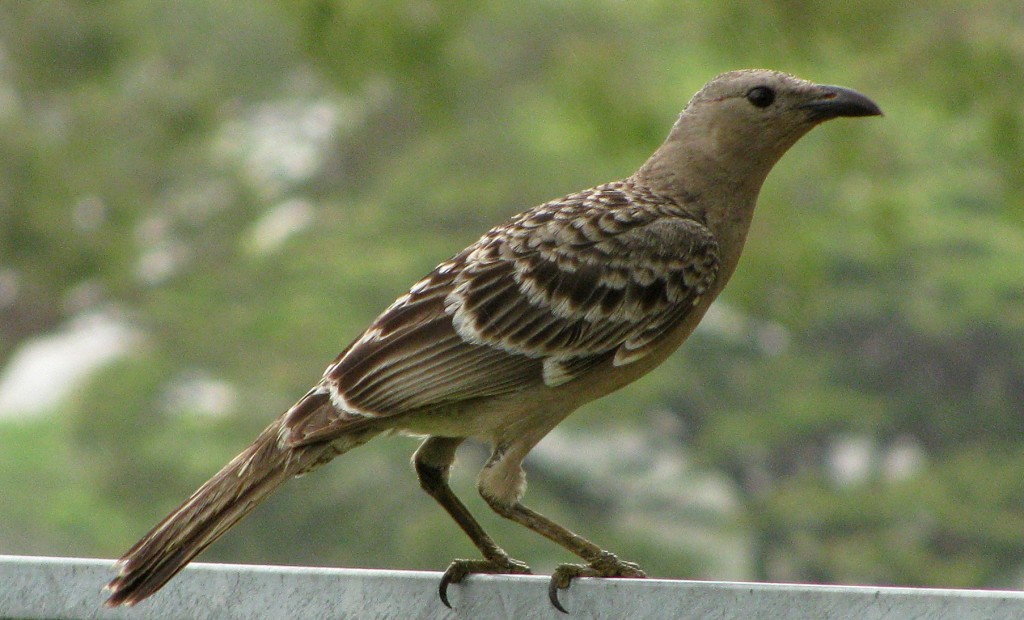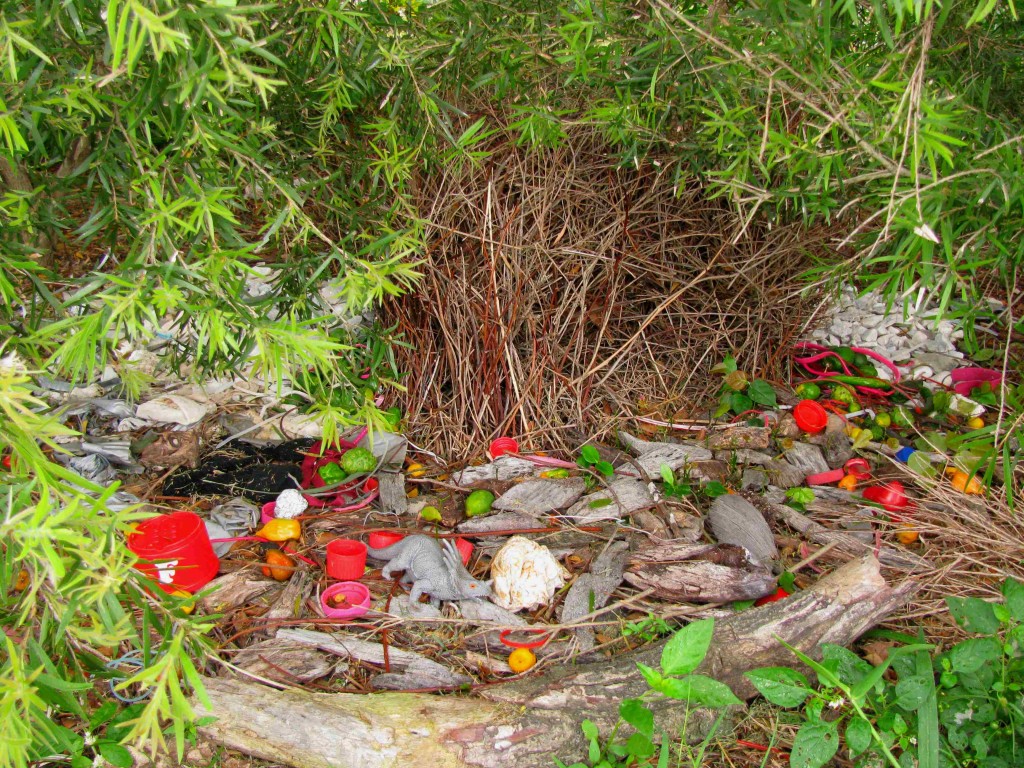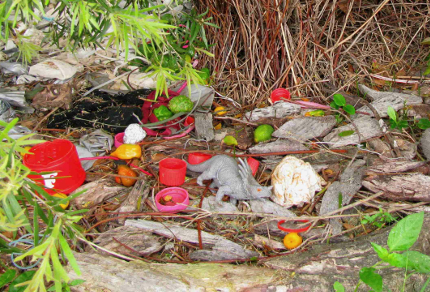
Juvenile Cane Toads (© Magi Nams)
Early this morning beside a drying wetland in the Townsville development of Fairfield Waters, lawns and beds of wood-chips squirted frogs – hundreds, thousands, perhaps millions of frogs. At first, I thought my footsteps were disturbing crickets, but when I looked more closely, I realized the tiny, dark hoppers leaping into the air around my feet were miniscule amphibians. Further inspection revealed squashed frogs flattened into delicate black embossings on sidewalks and dark smudges on a gravel path. I stepped carefully and attempted to guide my bicycle along the paths in such a way as to not add to the number of death-art embossings, all the while wondering into what population explosion I had unwittingly wandered. Was the abundance of 10-millimetre frogs the result of a mass hatching? Had recent rains acted as the catalyst? Were they – heaven forbid – baby cane toads? I photographed several of the frogs and determined to do my best to identify them later. [I was unsuccessful at identifying the frogs, so contacted Angus McNab, a keen young herpetologist, who ID’d them as juvenile cane toads, an introduced species that’s the scourge of Australia.]
The nasal honks of magpie geese rubbed against damp air as I looked out over the rank herbs and grasses grown up over much of the expanse of the wetland. Where water had formerly lain in broad pools and bellies, mud was covered with brilliant green, low-growing herbs, the geese resting on this mud near the edge of a stand of tall grasses. An intermediate egret hunted within the tall grasses, and snakebirds nested on broad rain tree boughs reaching out over the mud. Two whistling kites perched in a snag overlooking the wetland, the raptors’ feathers rumpled by a brisk wind.
As I observed the waterbirds, mist bordering on drizzle swept over the floodplain on which Townsville is built, shrouding the wetland in thick immediacy and nearly obscuring distant hills with scattered eucalypts on their crests, the sight of those sparsely-treed, rolling hills so intriguing to Vilis and me on our arrival in this country nearly ten months ago. Male and female anhingas (snakebirds) gurgled to each other beside a nest, the male austerely handsome in black highlighted with rusty-brown and white, the female demure in grey and buff. Nutmeg mannikins chirped quietly while feeding on grass seeds in the stand of dense, tall grasses, their peaceful chitterings a vivid contrast to the scratchy, yowling hisses emitted by a male great bowerbird fussing nearby.

Great Bowerbird, Chlamydera nuchalis (© Magi Nams)
Suddenly paying attention to the bowerbird, I wondered where its bower was. A thick hedge along a nearby fence was a likely spot, so I strolled past it, inciting the bowerbird into even more vociferous aggression. Sure enough, I spotted the bower, which would have been hard to miss, since it was the most lavishly decorated bower I’d ever seen.
Great bowerbirds are common in Townsville, and I’ve been fortunate enough to spot more than a dozen bowers in different areas of the city. Nearly all are positioned under dense shrubs or pockets of trees with low-spreading branches, and all possess an assortment of decorations intended to attract the interest of female bowerbirds.

Great Bowerbird Bower, Fairfield Waters, Townsville (© Magi Nams)
As decorations, I’ve seen stones and bones, seeds and fruits, glass and plastic, berries and stripped twigs, snail shells and clothespins, bits of bark, foil, duct tape or green canvas. However, this bower had a type of decoration I’d not seen before. It had toys. Two red, plastic stacking cups, one labelled with the letter F, lay sprawled upon a heap of pale decorations, in the company of an assortment of small, citrus-like fruits and red and pink plastic bottle lids. And then there was the dinosaur, a grey plastic ceratopsian with a spiny backswept frill over its neck, a horn on its schnozz, and red eyes. I wondered which neighbourhood yards and playpens the bowerbird had raided, and if a distressed boy or girl was still searching for a favourite dino or the stacking cups to complete a soaring tower.
Now the thought occurs to me that, if this were the bower of a satin bowerbird, the stolen toys would be blue or yellow.
Today’s birds: blue-winged kookaburras, white-gaped honeyeaters, rainbow bee-eaters, blue-faced honeyeaters, rainbow lorikeets, house sparrows, rock doves, yellow-throated miner, welcome swallows, brown honeyeaters, mynas, Australian magpies, figbirds, Australian pelican, yellow honeyeaters, little corellas, whistling kites, scaly-breasted lorikeets, willie wagtails, magpie geese, anhingas, great bowerbird, intermediate egret, nutmeg mannikins, sulphur-crested cockatoo, rufous-throated honeyeaters, spangled drongo, great egret, straw-necked ibis, white-breasted woodswallow. Also, countless miniscule cane toads.


